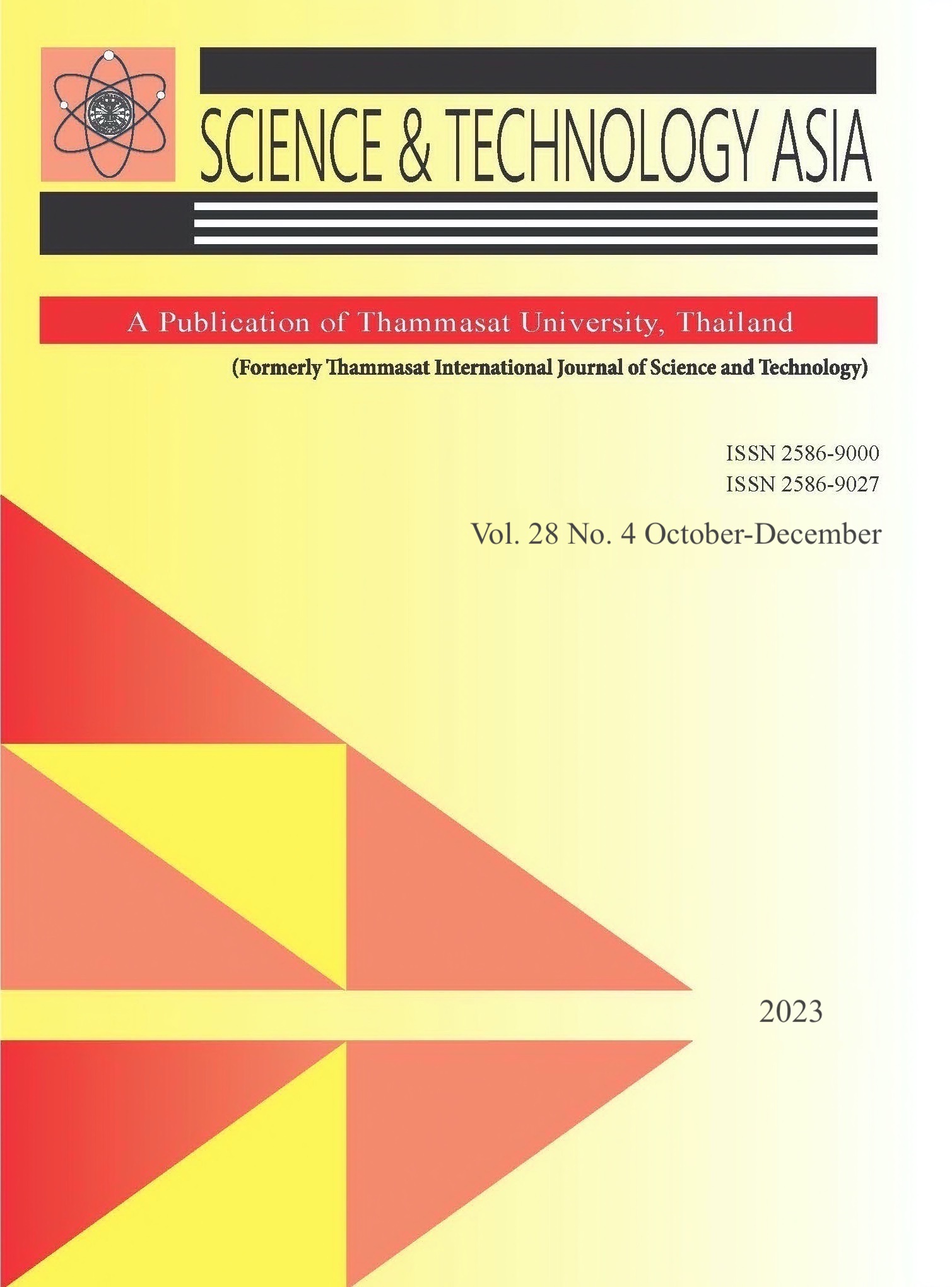Vermicompost Contained Fungi Act as Biocontrol Agents Against Fungal Pathogens of Chili
Main Article Content
Abstract
The present study aimed to isolate fungi found in vermicompost that exhibit antifungal activity against fungal pathogens of chili. The fungal pathogens were isolated from chili and their pathogenicity was tested and identified by morphology with sequence analysis of Internal Transcribed Spacer (ITS), Glyceraldehyde-3-Phosphate Dehydrogenase (GAPDH), and Betatubulin2 (TUB2) genes. The results indicated that fungal isolate B1 was identified as Colletotrichum siamense, a causative agent of chili anthracnose. The total fungi in the vermicompost was 2.64 x105 CFU/g with 32 fungal colonies of different morphology being isolated. The antifungal activity was observed with fungal isolates from vermicompost. Among these fungal isolates, 13 fungal isolates (40.63%) revealed antifungal activity against C. siamense with the percent inhibition in the range of 46.85-72.64%. The E10, E8 and F5 isolates revealed the highest percent inhibition of 72.75±4.81%, 71.70±5.45%, and 70.65±4.80%, respectively. The identification of fungal isolates E10, E8, and F5 by morphological study and sequence analysis of ITS, RPB2 (DNA-directed RNA polymerase II subunit 2), and TEF1 (Translation elongation factor 1) were examined. These isolates were identified as Trichoderma breve (E10) and T. zerobreve (E8 and F5). The findings of this study suggest that the fungal isolates from vermicompost with inhibitory activity against chili pathogen could support the use of vermicompost in chili plantations, not only for promoting plant growth but also for controlling fungal pathogens of chili anthracnose.
Article Details

This work is licensed under a Creative Commons Attribution-NonCommercial-NoDerivatives 4.0 International License.
References
Pakdeevaraporn P, Wasee S, Taylor PWJ, Mongkolporn O. Inheritance of resistance to anthracnose caused by Colletotrichum capsici in Capsicum. Plant Breeding. 2005;124(2):206-8.
Saxena A, Raghuwanshi R, Gupta VK, Singh HB. Chilli Anthracnose: The Epidemiology and Management. Frontiers in Microbiology. 2016;7.
Than PP, Jeewon R, Hyde KD, Pongsupasamit S, Mongkolporn O, Taylor PWJ. Characterization and pathogenicity of Colletotrichum species associated with anthracnose on chilli (Capsicum spp.) in Thailand. Plant Pathology. 2008;57(3):562-72.
Pathma J, Sakthivel N. Microbial diversity of vermicompost bacteria that exhibit useful agricultural traits and waste management potential. SpringerPlus. 2012;1:26.
Anastasi A, Varese GC, Marchisio VF. Isolation and identification of fungal communities in compost and vermicompost. Mycologia. 2005;97(1):33-44.
AOAC. Offical Methods of Analysis of AOAC International. 18 ed. Maryland. USA2005.
Yan Z, Anh V. Effect of Trichoderma sp. on Anthracnose Disease of Stored Chilli. Borneo Journal of Resource Science and Technology.
;8:90-102.
Raja HA, Miller AN, Pearce CJ, Oberlies NH. Fungal Identification Using Molecular Tools: A Primer for the Natural Products Research Community. Journal of Natural Products. 2017;80(3):756-70.
Khodadadi F, González JB, Martin PL, Giroux E, Bilodeau GJ, Peter KA, et al. Identification and characterization of Colletotrichum species causing apple bitter rot in New York and description of C. noveboracense sp. nov. Scientific Reports. 2020;10(1):11043.
Xing J-H, Sun Y-F, Han Y-L, Cui B-K, Dai Y-C. Morphological and molecular identification of two new Ganoderma species on Casuarina equisetifolia from China. MycoKeys. 2018;34:93-108.
Saitou N, Nei M. The neighbor-joining method: a new method for reconstructing phylogenetic trees. Molecular Biology and Evolution. 1987;4(4):406-25.
Felsenstein J. Confidence Limits on Phylogenies: An Approach Using the Bootstrap. Evolution. 1985;39(4):783-91.
Tamura K, Nei M, Kumar S. Prospects for inferring very large phylogenies by using the neighbor-joining method. Proceedings of the National Academy of Sciences of the United States of America. 2004;101(30):11030-5.
Kumar S, Stecher G, Li M, Knyaz C, Tamura K. MEGA X: Molecular Evolutionary Genetics Analysis across Computing Platforms. Molecular Biology and Evolution. 2018;35(6):1547-9.
Suwannarat S, Steinkellner S, Songkumarn P, Sangchote S. Diversity of Colletotrichum spp. isolated from chili pepper fruit exhibiting symptoms of anthracnose in Thailand. Mycological Progress. 2017;16(7):677-86.
de Silva DD, Groenewald JZ, Crous PW, Ades PK, Nasruddin A, Mongkolporn O, et al. Identification, prevalence and pathogenicity of Colletotrichum species causing anthracnose of Capsicum annuum in Asia. IMA Fungus. 2019;10(1):8.
Mukhopadhyay R, Kumar D. Trichoderma: a beneficial antifungal agent and insights into its mechanism of biocontrol potential. Egyptian Journal of Biological Pest Control. 2020;30.
Tyśkiewicz R, Nowak A, Ozimek E, Jaroszuk-Ściseł J. Trichoderma: The Current Status of Its Application in Agriculture for the Biocontrol of Fungal Phytopathogens and Stimulation of Plant Growth. International Journal of Molecular Sciences. 2022;23(4):2329.
Zee Kar Y, Vu Thanh Tu A. Effect of Trichoderma sp. on Anthracnose Disease of Stored Chilli. Borneo Journal of Resource Science and Technology. 2018;8(2).
Gu X, Wang R, Sun Q, Wu B, Sun J-Z. Four new species of Trichoderma in the Harzianum clade from northern China. MycoKeys. 2020;73:109-32.
Chavez-Jalk A, Leiva S, Bobadilla LG, Vigo CN, Arce M, Oliva-Cruz M. Effect of Endophytic Trichoderma sp. Strains on the Agronomic Characteristics of Ecotypes of Theobroma cacao L. under Nursery Conditions in Peru. International Journal of Agronomy. 2022;2022:5297706.
Rahman MA, Ansari TH, Alam MF, Moni JR, Ahmed M. Efficacy of Trichoderma against Colletotrichum capsici Causing Fruit Rot Due to Anthracnose of Chili (Capsicum annum L.). The Agriculturists. 2018;16(02):75-87.


